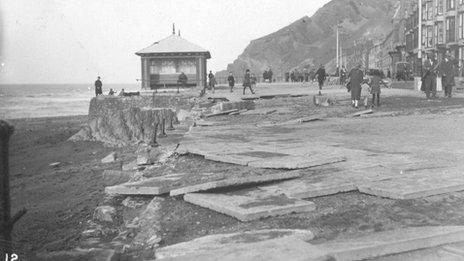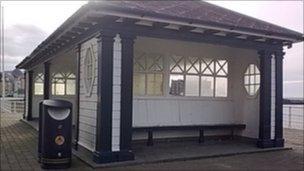Aberystwyth seafront storm damage clean-up attracts 200
- Published
More than 200 volunteers helped clear up the promenade
Two hundred people volunteered to help with a clean-up of Aberystwyth promenade, a week after it was damaged by storms.
Work by contractors to remove a grade II-listed seafront shelter has also started.
The 1920s landmark was badly damaged and is being dismantled for repair.
Ceredigion council aims to completely re-open the promenade to the public by Easter after it was battered by high tides and storms.
Volunteers had been asked to join the promenade clean-up at 10:00 GMT and more than 200 turned out, with buckets and shovels.
As well as students, one man had travelled from Gloucestershire to help clear shingle from the walkway.
Elsewhere, the A487 in Newgale, Pembrokeshire, has been reopened after tonnes of shingle washed onto it during the storm.
Engineers spent several days using earth moving equipment to move the shingle off the road and back onto the beach.
Massive waves
But it was Aberystwyth that was hardest hit by the heavy rain, strong winds and high tides.
The town's shelter partly fell into a hole after its foundations were washed away as massive waves pounded the seafront on 6 January.
Cadw, the body which looks after Wales' historic monuments for the Welsh government, has told Ceredigion council it wants the shelter to be repaired and replaced in its current position.
The council has said it does not know how long the dismantling process will take or how much it will cost.
But it is hoping to have the full length of road along the promenade from the harbour car park to the base of Constitution Hill open by late Sunday night.

The shelter survived the 1927 storm after being built earlier that decade
A council spokesman said the local authority would be able to start accessing the damage to the promenade walkway on Monday.
"Early signs are that there are three main areas to repair between the bandstand and Constitutional Hill," he said.
"Depending on weather conditions, the aim is to enable the public to use the promenade by Easter Monday, apart from the area which will remain fenced off around the bathhouse shelter."
Finally succumbed
Aberystwyth seafront shelter has been used by couples, rowdy students, sodden holidaymakers and the homeless since it was built in the 1920s.
The building has survived major storms in 1927 and 1938 and a plan to demolish it in 2010.
But it finally succumbed to the elements during storms that lashed the seaside town last week.
The Bath Rock shelter was built around 1923/24 and the earliest photograph is on a book from 1925.
A Bath House had previously been on the site between 1810 and 1892.

The shelter was restored in 2011
Local historian and former curator of Aberystwyth-based Ceredigion museum, Michael Freeman, said: "Water was drawn in from the sea by a horse-drawn pump and heated up by a boiler to enable people who weren't able to go into the sea to have a bath or shower."
He added the bath house's foundations may be the root-cause of the serious damage to the shelter last week.
"The waves were able to punch a hole through the foundations because it would have been filled in with rubble when the shelter was built," he said.
But it survived two major storms in the first two decades of its existence on 28 October 1927 and on 14 January 1938.
Buckets, spades - and wheelbarrows on Aberystwyth seafront
The devastation caused by the hurricane-force winds that hit Aberystwyth seafront in 1938 was recorded by British Pathe in the aftermath of the storm.
The cost of last week's storm is not known yet but the total bill in 1938 was £70,000 or about £2.5m by today's standards.
In 2010 Ceredigion Council proposed to replace the two public shelters on the prom with new ones at a cost of £60,000.
At the time the council said the shelter was becoming too costly to repair.
But it was restored rather than scrapped in 2011 after it was made a grade II-listed building by Cadw.
- Published10 January 2014
- Published8 January 2014
- Published6 January 2014
- Published9 January 2014